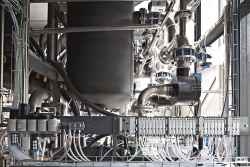
Posted to News on 14th Aug 2014, 10:09
Wash, rinse, dry: cleaning mass-produced automotive parts
The Multiclean-D-4-4-F full vacuum plant from Hckh is a true giant among washing machines. While the drum of a household washing machine can hold 6kg at any one time, an industrial washing machine recently delivered to a German customer can take two 600kg loads of metal parts for the automotive industry. Festo's valve terminal technology keeps the twin-chamber cleaning plant running smoothly.

In metalworking, greases and special emulsions protect cutting tools against wear. While this is good for the machines, it leaves a residue on the metal parts and must be removed before further processing. Assembly processes or surface treatments such as galvanising or painting require clean parts. Depending on the application, aqueous cleaning solutions or solvents can be used.
Solvents are preferable to aqueous cleaners for oily mass produced parts for the automotive industry as they are quick, economical and resource-saving. A new twin-chamber perchlorethylene-based cleaning plant from Hckh Metall-Reinigungsanlagen GmbH has raised the bar with operation under full vacuum.
When integrated into the production cycle, it increases part throughput significantly. Up to 10 crates filled with pressed and stamped parts pass through the system every hour in a three-shift operation. State-of-the-art valve terminal technology from Festo contributes to this excellent performance.
The capacity of the huge washing machine for metal parts is simply enormous. In addition to rapidly cleaning large volumes of metal parts in either a 65 degree or 98 degree wash with liquid or vaporous perchlorethylene, the system also dries the parts using a vacuum after they have been washed. And all of this in less than 15 minutes per crate.
Before that, the pressed parts are transported in bulk. Forklift trucks move the parts in crates measuring approx. 900 × 800 × 850mm and with a total weight of between 500 and 600kg. To select the right programme, the system operator simply scans the bar code on the accompanying ticket. As soon as he has left the loading area, automatic feeding begins and the crate is transported to the next free process chamber. To achieve the required capacity of 10 batches per hour in a three-shift operation, the process has been divided between two chambers.
The loading gantry then loads the rotating crate holder and a Festo standard cylinder DNG with a stroke of 180cm closes the sliding door of the process chamber vacuum tight. When it reaches the last few centimetres, a clever toggle lever mechanism ensures it is firmly closed.
Ten batches per hour
Depending on the parts type, this is then followed by an individual cleaning programme, which can be made up of various modules such as evacuation of the process chamber to process vacuum, pre-washing in the spray process, flood cleaning (full bath) from tank one, post washing in the spray process, flood cleaning (full bath) from tank two, vapour degreasing with solvent vapour and vacuum drying. A limit value encoder monitors the drying process so that only completely dry, solvent free parts are removed from the process chamber.
The cleaned parts then pass through a cooling tunnel on the unloading roller conveyor so that the crates can be packed directly for shipment. To achieve flexibility, the system was designed as three separate modules.
For cleaning there are two identical, completely independent cleaning modules with process chamber, twin tank, distillation plant, pumps and filters. Because of standalone operation, one module can be switched off in the event of maintenance or low capacity utilisation and the system can continue to operate at half capacity. Both cleaning modules are connected to a central supply module, which houses the vacuum pumps as well as the activated carbon absorber for process air preparation.
The entire vacuum performance of over 1000m ³/h can be divided into variable ratios between the two process chambers if required. This ensures a very high throughput for the size of the chamber and the complexity of the process of 10 batches per hour.
Reliable process engineering
This demanding process is kept running smoothly by a variety of Festo components. These include valve terminals type CPX/MPA with Profibus control. These valve terminals look after all of the process engineering, activate the angle seat valves and the actuators, ensure the crates are locked and control the liquid transport and the vacuum.
Thanks to "intelligence on the terminal', the cleaning plant from Hckh does not require any additional multi-pin cables. The MS series service unit ensures correct and reliable compressed air preparation. Festo's technology also offers a condition monitoring option. Values such as maximum, peak and average consumption as well as effective and apparent power are displayed.
For more information about Festo's valve terminal technology, please go to www.festo.co.uk.






























